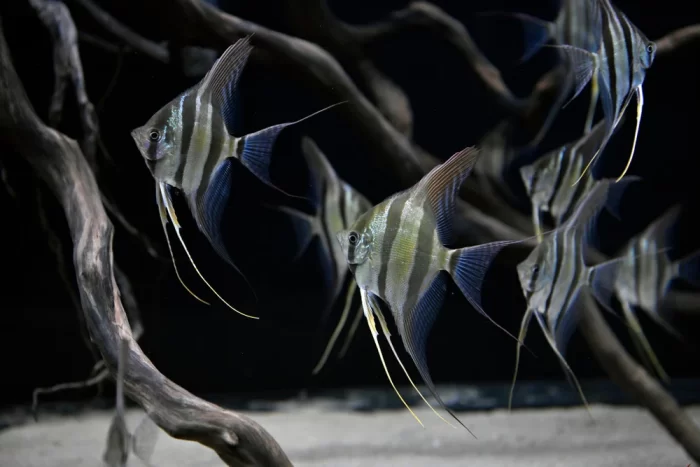Angelfish are some of the most popular freshwater aquarium fish and for good reason. Their unique shape and vibrant colors make them true standouts in any tank. In this article we talk about 7 Stunning Varieties of Angelfish You Should Know About.
If you’re looking to add a splash of beauty and wonder to your aquarium, angelfish should be at the top of your list. But with over 90 varieties, how do you choose?
In this blog post, we’ll highlight 7 of the most stunning angelfish that are sure to be the stars of your tank. From marble patterns to electric blues, let’s dive in!
Table of Contents
Marble Angelfish
The marble angelfish is a kaleidoscope of black, white, and orange. No two marble angels look exactly alike – each has a unique pattern and color intensity.
As juveniles, marbles may start more subdued. But as they mature, their colors become bolder and more well-defined. The contrast makes them pop against planted backgrounds.
Fun fact: No two marble angelfish have the same pattern. So yours will be one-of-a-kind!
Silver Angelfish
Don’t let the name fool you. Silver angelfish shimmer as their scales reflect light. What makes them stand out is the inky black edges on their fins, creating a definition against the silver backdrop.
Silvers are a wild-derived angelfish. This means their coloration closely resembles angels found in the Amazon river system. For an angelfish that looks like it just swam out of the rainforest – silver angels are it!
Gold Angelfish
Gold is the color of luxury, and the gold angelfish lives up to its name. Metallic gold scales cover its entire body, from nose to tail. Its fins fade to black for bold contrast.
Under bright light, gold angels emit a radiant glow. They especially pop when paired with a dark substrate and plants. Their shine adds a touch of glamour to any freshwater tank.
Blushing Angelfish
Don’t be fooled by the blushing angelfish’s demure name. While they start small and silver, they transform as they mature.
Eventually, red begins blooming on their cheeks and gill plates. The effect resembles a maiden blushing. The red intensifies over time until they display rubies and sapphires against silver skin.
The red gene also manifests in their eyes, turning them into a startling ruby hue. It’s this combination that gives blushing angels their distinctive beauty.
Black Lace Angelfish
Black lace angelfish provides a stark contrast to the usual color varieties. As their name suggests, their bodies are covered in a black lace-like pattern over silvery skin.
The black tracing creates a delicate filigree appearance. It branches across their entire bodies including their fins. When illuminated, the silver shines through the dark lacings for a striking effect.
The black lace gene also influences their eyes, turning them a dark ruby red. This piercing gaze contrasts beautifully with their lace patterns.
Electric Blue Angelfish
If you want showstoppers, look no further than electric blue angelfish. Their entire bodies, from head to tail, are covered in dazzling metallic blue. They seem to emit a neon glow that makes them the focal point of any aquarium.
Electric blues are engineered by breeders to have brilliant blue coloration. The electric blue gene removes any dark edges, resulting in an unbroken rich tone. The effect is a living burst of blue!
Koi Angelfish
Koi angelfish draws inspiration from the famed koi fish. They have a white base color, overlaid with orange and black markings. These can present as dots, patches, or swirling patterns.
Like koi fish and marbles, no two koi angels have quite the same look. But what they share is an undeniable beauty that originated from Asian ornamental carp so many years ago.
The white, orange, and black stand out brightly whether displayed alone or in groups. If you appreciate both angelfish and koi fish – look no further than the koi angelfish!
Choosing Your Stunning Angelfish
Now that you know a bit about these 7 showstopper varieties of angelfish, how do you pick the ones for your tank?
Consider what color tones you want to emphasize in your aquascape. For example, electric blues and gold really pop against dark substrates and backgrounds. Meanwhile, silvers and marbles look stunning with natural planted setups.
You’ll also want to think about angelfish behavior. Do you want a community tank or to showcase a mated pair? Some varieties like koi and blushing angels are known for being more aggressive. They are best kept solitary or in larger groups of 6+.
Finally, select angelfish that capture your eye! Part of the fun is choosing varieties you find beautiful. With over 90 types of angels, you’re sure to discover some new stunning favorites.
Set Up Your Angelfish For Success
Once you select your angelfish, be sure to set up their tank for health and happiness. Here are a few key tips:
- Minimum 29-gallon tank
- Water temperature of 82°F – 86°F
- pH between 6.8 and 7.0
- Plants and driftwood to provide hiding spots
- Substrate for foraging like sand or small gravel
- Filter rated for a 50 gallon+ tank to keep water clean
- A diet rich in protein, vitamins, and vegetable matter
Following these guidelines, your angelfish will thrive for years to come. Their colors should also grow more resplendent as they mature.
Dazzling Angelfish for Dazzling Tanks
Angelfish offers timeless beauty with their graceful flowing fins and vibrant colors. It’s no wonder aquarists have prized them for over a century.
We hope this overview of 7 spectacular angelfish varieties has helped you discover some new favorites. Whether you’re drawn to the lace-like patterns of black lace angels, or the striking glow of electric blues, angelfish make excellent showcase fish.
When cared for properly, angelfish will reward you with brilliant colors and dynamic movement for years on end. We can’t wait to see what dazzling varieties breeders come up with next. I sincerely hope you find this “7 Stunning Varieties of Angelfish You Should Know About” article helpful.

Marta, the driving force behind WaterWorldCraze.com, holds a Master’s degree in Marine Biology and has extensive experience in water sports and activities. With over 7+ years of hands-on experience in marine research and conservation, she has participated in numerous underwater expeditions and projects. Her passion for the aquatic world shines through in her expertly curated content. Join Marta as she explores the wonders of marine life and shares her adventures. Connect with her on Instagram @marinebiologymarta for more insights and updates.

